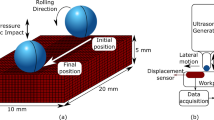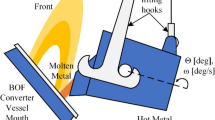Abstract
Multi-stand roll forming is a process that has very complicated deformation behaviour and shows significant nonlinearity. In this paper, the sensitivity analysis of parameters for multi-stand roll forming was performed via a new booting finite element method (FEM) model. Compared with the most of simulation, the new model is more consistent with production process and can account for the effects of roll rotating speed. Based on the model, the process of an open section channel formed with 10 passes was simulated and the sensitivity analysis was conducted with orthogonal experiment design combined FEM model. The multi-stand roll forming process can be efficiently analyzed by the new booting model. And sensitivity analysis shows the hardening exponent plays an important role in controlling the quality of the products.
Similar content being viewed by others
References
Kiuchi M, Abe K, Onodera R. Computerized numerical simulation of roll forming process [J]. CIRP Annals-Manufacturing Technology, 1995, 44(1): 239–242.
Nitin D, Mustafa A A, Gary L K, et al. Computer aided simulation of cold roll forming—a computer program for simple section profiles [J]. Journal of Materials Processing Technology, 1996, 59(1–2): 41–48.
Brunet, M. Ronel S. Finite element analysis of roll forming of thin sheet metal [J]. Journal of Materials Processing Technology, 1994, 45(1–4): 255–260.
Brunet M, Mguil S, Pol P. Modeling of a roll-forming proves with a combined 2D and 3D FEM code [J]. Journal of Materials Processing Technology, 1998, 80: 213–219.
Nefussi G, Gilormini P. A simplified method for the simulation of cold-roll forming [J]. International Journal of Mechanic Science, 1993, 35(10): 867–878.
Frank H, Haydar L, Mustafa A A, et al. Simulation of roll forming process with 3-D FEM code PAM-STAMP [J]. Journal of Materials Processing Technology, 1996, 59(1–2): 59–67.
Sukmoo H, Seungyoon L, Naksoo K. A parametric study on forming length in roll forming [J]. Journal of Materials Processing Technology, 2001, 113(1–3): 774–778.
Han Z W, Liu C, Lu W P. Computer simulation of a non-symmetrical-section steel forming process by the spline finite strip method based on U.L. method [J]. Journal of Materials Processing Technology, 2000, 103(3): 343–346.
Kim N, Oh S I. Analysis tool for roll forming of sheet metal strips by the finite elements method [J]. Ann CIRP, 1999, 48(1): 235–242.
Alsamhan A, Hartely P, Pillinger I. The computer simulation of cold-roll forming using FE methods and applied real time re-meshing techniques [J]. Journal of Materials Processing Technology, 2003, 142(1): 102–111.
Author information
Authors and Affiliations
Corresponding author
Additional information
Foundation item: the National Natural Science Foundation of China (No. 50605043)
Rights and permissions
About this article
Cite this article
Zeng, G., Lai, Xm., Yu, Zq. et al. Sensitivity analysis of parameters for multi-stand roll forming using a new booting model. J. Shanghai Jiaotong Univ. (Sci.) 13, 707–711 (2008). https://doi.org/10.1007/s12204-008-0707-2
Received:
Published:
Issue Date:
DOI: https://doi.org/10.1007/s12204-008-0707-2




